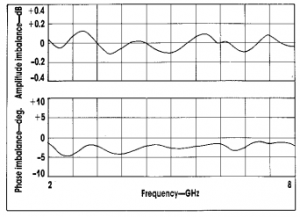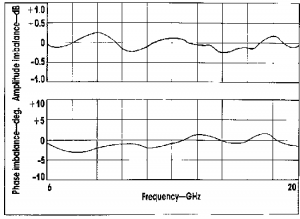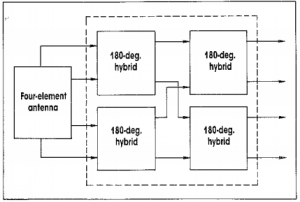This article was originally published in a Microwaves & RF article, in December 1988.
Hybrids perform many functions, including splitting and combining signals in amplifiers, switching circuits, and antenna beam-forming networks. The 4000000 series 180-deg. hybrids from KRYTAR (Sunnyvale, CA) deliver this versatility over broad bandwidths— from 2 to 20 GHz—with output signals evenly matched in both amplitude and phase.
Hybrids are four-port components, with dual input and output ports. A signal applied to the sum (⅀) input port produces two output signals of matched amplitude and phase. In 3-dB hybrids such as the 4000000 series, each output level is 3-dB lower (less the insertion loss through the hybrid) than the input level.

Signals applied to the difference (A) input port produce two equal-amplitude output signals that are 180 deg. out of phase with each other. This characteristic makes such hybrid circuits ideal for reducing noise in amplifiers via feedback combining techniques or for merging multiple signals from arrays.
Hybrids in the 4000000 series cover large segments of the full 2-to-20- GHz frequency range, including 2 to 8 GHz in the model 4020080, 2 to 18 GHz in the model 4020180, and 6 to 20 GHz in the model 4060200. The hybrids are realized with a doublearrow construction technique (Fig. 1) in which two stripline, 8.34-dB, asymmetric, tapered-line directional couplers are cascaded.1 Meandering transmission lines on each side of the hybrid maintain the even 180deg. phase relationship between channels at all frequencies.
Fabrication of the double-arrow hybrids requires an asymmetric coupler with completely overlapped lines at its coupled end (where the lines cross) that form an instantaneous transition from high coupling to no coupling. The hybrids are realized with a three-layer stripline configuration. Coupled lines are etched on opposite sides of a thin coupler circuit board, sandwiched between a pair of equal-thickness 5880 Duroid dielectric boards from Rogers Corp. (Chandler, AZ).
| Model No. | Frequency (GHz) | Insertion loss (dB) | Amplitude imbalance (dB) | Phase imbalance (deg.) | Maximum isolation (dB) | Maximum VSWR |
| 4020080 | 2.8 | 1.1 | ±0.3 | ±8 | 18 | 1.4:1 |
| 4040124 | 4- 12.4 | 0.9 | ±0.4 | ±8 | 17 | 1.6:1 |
| 4010124 | 1 – 12.4 | 2.0 | ±0.4 | ±10 | 17 | 1.6:1 |
| 4020180 | 2 – 18 | 2.0 | ±0.5 | ±14 | 15 | 1.7:1 |
| 4060200 | 6 – 20 | 1.2 | ±0.6 | ±10 | 15 | 1.7:1 |

The results are impressive (see table below). Amplitude imbalance—the amount of level variation between a hybrid’s two outputs—is no worse than ±0.3 dB in the model 4020080 (Fig. 3) and is less than ±0.5 dB in the model 4060200 (Fig. 4). Insertion loss is never more than 2 dB for models 4020180 and 4010124 and less than 0.9 dB for the 4-to-12.4-GHz model 4040124. Isolation is better than 15 dB for all models, and VSWR is held below 1.7:1 at all frequencies. Measurements were made on an HP 8510 vector network analyzer from Hewlett-Packard Co. (Palo Alto, CA).
Five Hybrids at a glance

Broadband hybrids have traditionally been developed in 90-deg. configurations, with less bandwidth generally available for the greater phase relationship of 180-deg. hybrids. Systems such as antenna beam-forming networks can be designed more efficiently with 180deg. hybrids, however, since less components are required to recombine divided signals. The double-arrow configuration of the 4000000 series overcomes many of the bandwidth restrictions that have limited the use of 180-deg. hybrids in the past. Use of 4000000 series hybrids allows a typical EW beam-forming network (Fig. 5) to be housed in a single, compact enclosure.

Standard 4000000 series hybrids are supplied with SMA connectors, although other connector types are available. The components are rugged in design and built to withstand military environments. P&A: $525 (4020080), $675 (4040124), $825 (4010124), $975 (4020180), and $825 (4060200); 2 to 4 wks.
Reference:
1. H. DuHamel and M.E. Armstrong, “The tapered-line Magic-T: parallel coupled lines and directional couplers,” Arteeh House, City, MA, 1972, pp. 207-233.


